Cape St. Mary’s Ecological Reserve is one of the best and most accessible places in the world to see nesting seabirds.
- How to get There
- Activities
- Maps
- Services
- Fees and Schedules
- Rules and Regulations
- Permits
- Other Resources
- Contact Information
Located about 200 km southwest of St. John’s, Cape St. Mary’s Ecological Reserve also known as “the Cape” is one of Newfoundland and Labrador’s major seabird colonies. During the breeding season, it is home to 30,000 Northern gannet, 20,000 black-legged kittiwake, 20,000 common murre, and 2,000 thick-billed murre. In addition, more than 100 pairs of razorbill, more than 60 pairs of black guillemot, plus double-crested and great cormorant, and Northern fulmar nest there.
What makes it so spectacular, however, is that all these birds can be seen from land, as close as 10 metres away.
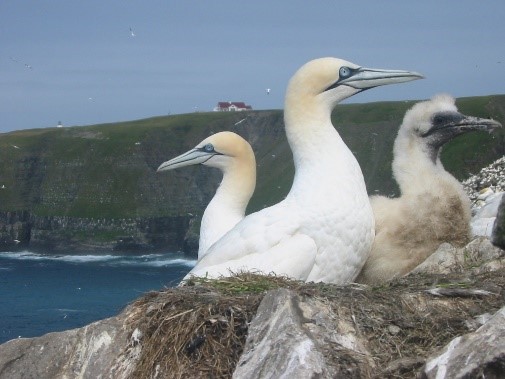
Most of the Northern gannets, for example, make their nests on “Bird Rock”-a 100-metre-tall stack of sandstone that is separated from the viewing area by a chasm only a few metres wide. The gannets’ courtship, nesting, and feeding behaviours, interactions, and delicate flying manoeuvres over the crowded sea stack are endlessly fascinating and easily observed from the natural, cliff-top viewing area, even on foggy days.
Bird Rock is reached by a 1.4km footpath through the open meadows that top steep cliffs, where wild iris grow and sheep sometimes graze. Cape St. Mary’s is within the Eastern Hyper-oceanic Barrens ecoregion (861 KB), one of the world’s most southerly expanses of sub-Arctic tundra. Mosses, lichens, alpine wildflowers, and low-growing shrubs carpet the seemingly treeless plateau over which visitors walk. The area has ponds, bogs, brooks-and sheer cliffs plunging down to the sea. Offshore, during the summer, whale spouts can often be spotted.
Particularly in the early part of the breeding season (April through June), the weather at Cape St. Mary’s can be damp, foggy, and cool. The average temperature in July is 14 ℃ and there are 200 days of fog a year, on average, at the Cape. On such days, the attractions of the modern, bright Interpretive Centre are particularly strong. The birds and their environment are interpreted inside. The building is located near the parking lot and Coast Guard operated lighthouse, which was originally built in 1860.
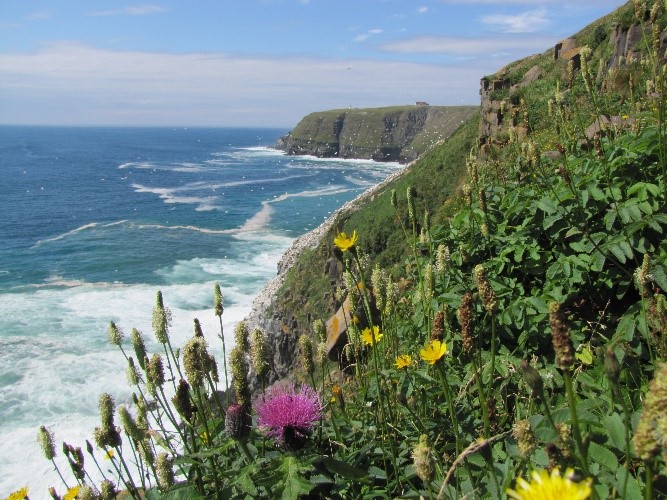
Visitors should take care when walking in the fog, particularly near cliffs and when and where the trails are slippery. Check with staff at the Interpretive Centre for trail conditions before setting out.
Cape St. Mary’s Ecological Reserve covers 64 km2; 54 km2 of this is the marine portion. The waters offshore are an important wintering site for thousands of sea ducks, including harlequin, common eider, scoter, and long-tailed duck.
Cape St. Mary’s was established as an ecological reserve in 1983.
For more information or to book a tour, contact:
How to get there
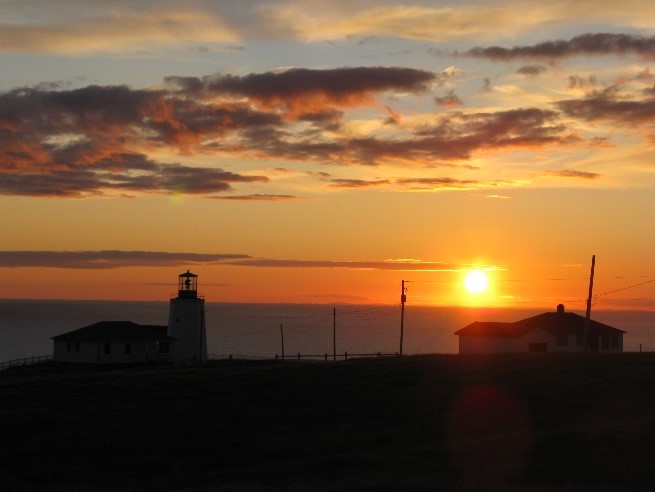 Cape St. Mary’s is located at the southwestern tip of Newfoundland’s Avalon Peninsula. It’s a two-and-a-half hour drive from St. John’s (Trans-Canada Highway/Route 1 to the Cape Shore highway/Route 90), and about an hour from Argentia/Placentia.
Cape St. Mary’s is located at the southwestern tip of Newfoundland’s Avalon Peninsula. It’s a two-and-a-half hour drive from St. John’s (Trans-Canada Highway/Route 1 to the Cape Shore highway/Route 90), and about an hour from Argentia/Placentia.
The turnoff to the reserve access road is about 5 km east of St. Bride’s and 15 km west of Branch.
The path to Bird Rock is not wheelchair accessible, but the Interpretive Centre is fully accessible.
Aircraft are prohibited from landing in the reserve, or flying lower than 300 metres from April 1 to October 30. No tankers or vessels longer than 20 metres are permitted in the marine portion of the reserve.
Activities
Proper footwear is required for our natural trail, which is often wet and slippery due to foggy and damp weather. Please note that service dogs are the only animals permitted within the boundaries of the reserve.
Bird and wildlife watching
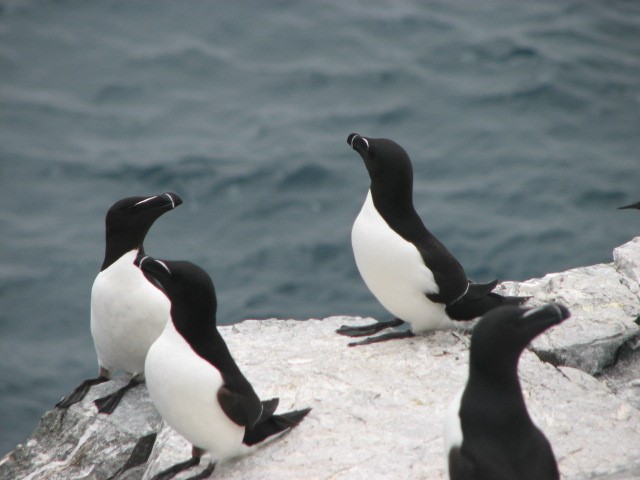 The major activity at Cape St. Mary’s is watching and learning about seabirds. This can be done on a guided tour, in the Interpretive Centre, or on your own. Please note that the path to Bird Rock is not wheelchair accessible, but the Interpretive Centre is fully accessible.
The major activity at Cape St. Mary’s is watching and learning about seabirds. This can be done on a guided tour, in the Interpretive Centre, or on your own. Please note that the path to Bird Rock is not wheelchair accessible, but the Interpretive Centre is fully accessible.
In addition to the major colonies of nesting seabirds-Northern gannet, black-legged kittiwake, common murre, and thick-billed murre-you can see razorbill, black guillemot, double-crested and great cormorant, and Northern fulmar. Offshore, during the summer, whales, dolphins, porpoises, and seals can be spotted. Migrating shorebirds and raptors visit in fall and spring. And harlequin ducks, common eiders, other sea ducks are in the area during winter.
The path to the main observation point leaves from the parking lot, and is a 1-km walk over cliff-top barrens. The bird observation lookout adjacent to Bird Rock has limited space; visitors are asked to take turns, and avoid crowding. The breeding season for most species is April through October.
While you can walk to the Bird Rock observation area on your own, please be careful. Use caution near cliffs and check with Interpretive Centre staff for information on trail conditions. Visitors are asked to stay on the main path, walk carefully (particularly in foggy or slippery conditions), and avoid areas where birds are breeding, as well as cliff edges and steep slopes. You may encounter loose rock or sheep manure on the path.
Other Events and Activities
The staffed Interpretive Centre has displays, programs, and activities about the birds and their environment. During the summer, it sometimes offers musical and other general attractions. In addition, educational and special events are often offered at the Cape that are supported by a group of volunteers – the Friends of Cape St. Mary’s. Anybody can become a member of Friends of Cape St. Mary’s for a fee of $20.00.
Commercial and recreational fishing can occur in the waters of the reserve within limits. All provincial and federal regulations apply when fishing in the reserve. Boaters must be careful in the marine portion of the reserve so as not to disturb the birds.
Services
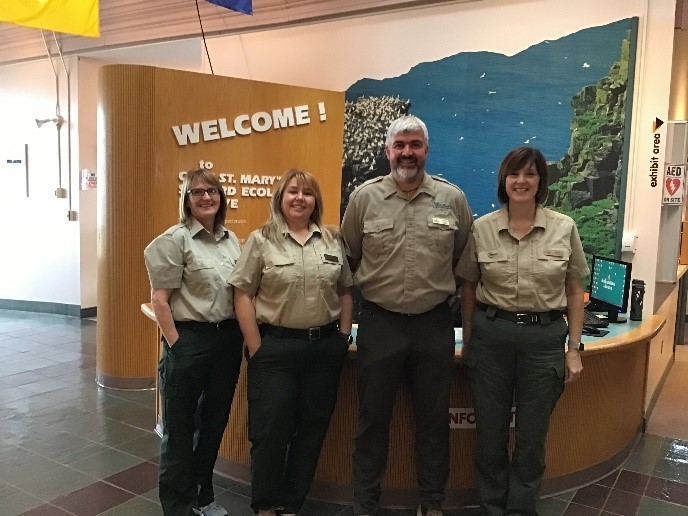 The Interpretive Centre is open seven days a week from May to October. Check Fees & Schedule for this year’s opening and closing dates or call the Interpretive Centre for opening hours.
The Interpretive Centre is open seven days a week from May to October. Check Fees & Schedule for this year’s opening and closing dates or call the Interpretive Centre for opening hours.
The Interpretive Centre is staffed, and has wheel-chair accessible public washrooms. The path to Bird Rock is not wheelchair accessible, but the Interpretive Centre is fully accessible.
Group tours are asked to book in advance; please call:
Tel: (709) 277-1666
Fees and Schedule
There are no fees involved in visiting the reserve or obtaining the various permits.
The Interpretation Centre has a Nature Store and washrooms. Friends of Cape St. Mary’s accepts donations as it exists primarily to support Cape St. Mary’s Ecological Reserve and to fulfill the mandate to preserve the natural area.
PLEASE BOOK AHEAD FOR GUIDED GROUP TOURS
Tel: (709) 277-1666
Rules and Regulations
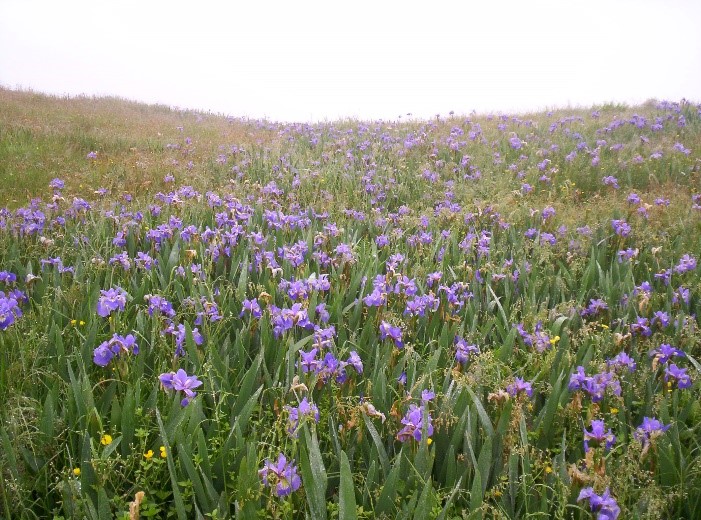 Biodiversity protection and habitat conservation are two of the key purposes of ecological reserves, so certain rules apply within all the reserves in the province.
Biodiversity protection and habitat conservation are two of the key purposes of ecological reserves, so certain rules apply within all the reserves in the province.
The public can visit most ecological reserves for educational purposes or low-impact recreational activities, such as hiking or sightseeing.
The following activities are strictly prohibited in all wilderness and ecological reserves:
- Disturbing, destroying, or removing plants, animals, or fossils
- Introducing plants, animals, or anything else to the reserve landscape
- Forestry, mining (including exploration), hydro development, agriculture, new roads, tracks, or buildings
- Driving off-road vehicles including all-terrain vehicles (ATVs)
In addition, at Cape St. Mary’s Ecological Reserve:
- Pets are not permitted in the reserve.
- A person may enter the reserve with a service animal which is to be is kept under control at all times.
- No hunting is allowed in the reserve.
- Motorized boats are not permitted within 100 metres of the cliffs containing nesting birds during the breeding season (April 1-October 30).
- Non-motorized boats can approach to 20 metres of the cliffs containing nesting birds during the breeding season (April 1-October 30).
Complete rules and regulations for scientific researchers, fishers, local residents, commercial tour boat operators, Coast Guard staff, and other potential visitors are available online.
Read the official reserve regulations:
- Seabird Ecological Reserve Regulations
- Cape St. Mary’s Ecological Reserve Order
- Wilderness and Ecological Reserves Act
Adobe® Acrobat® Reader software can be used for viewing PDF documents. Download Acrobat® Reader for free
